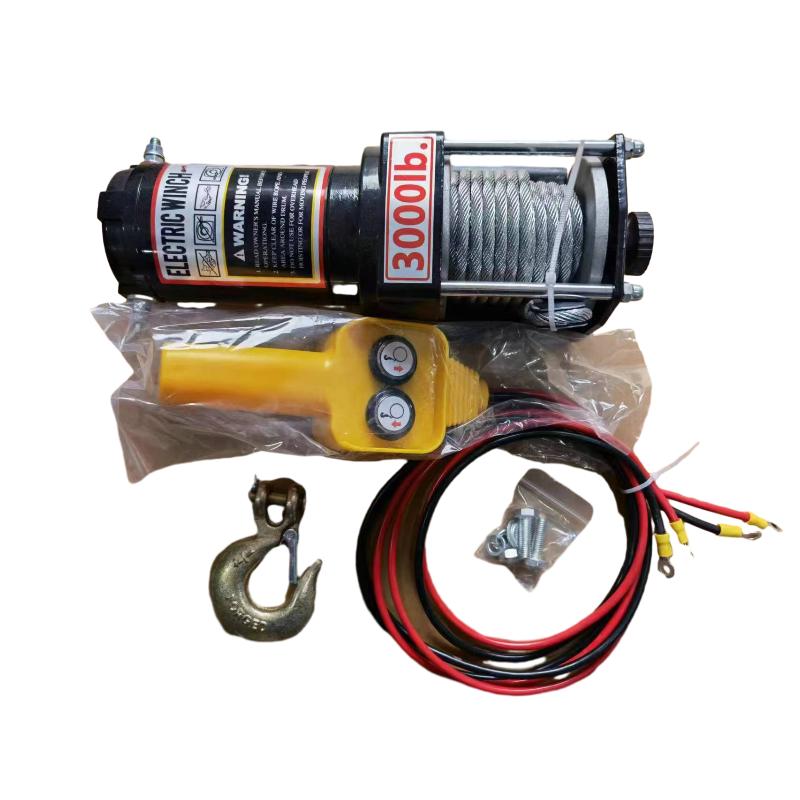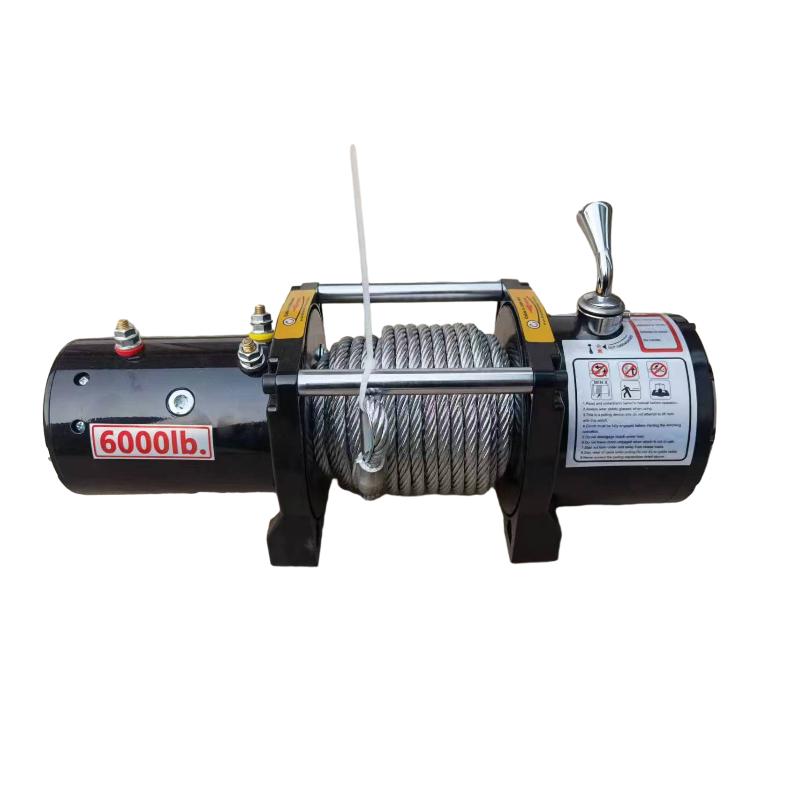


The industrial lifting and pulling sector is undergoing a transformative shift, driven by demands for greater efficiency, enhanced safety, and unparalleled precision. In this evolving landscape, the electric hand winch stands out as a pivotal technological advancement, moving beyond traditional manual or hydraulic systems to offer superior control and operational agility. Current industry trends highlight a strong gravitation towards automation and intelligent solutions, where winches are no longer just mechanical devices but integrated components within complex operational frameworks. We are observing significant advancements in motor technology, such as the widespread adoption of Variable Frequency Drives (VFDs) for precise speed control and energy optimization, alongside sophisticated braking systems that offer fail-safe operation. Furthermore, the imperative for robust construction and corrosion resistance, especially in harsh environmental conditions like offshore drilling or chemical processing plants, is shaping material choices and surface treatment techniques. This commitment to durability directly translates into reduced downtime and extended service life, critical factors influencing the overall electric winch price and long-term return on investment for B2B stakeholders. The market is also witnessing a surge in demand for customizable solutions, ranging from specific load capacities, such as a high-performance 2 ton electric winch, to tailored control interfaces and integration with existing PLC systems, reflecting a deeper understanding of unique industrial challenges and the need for adaptable machinery.
The journey of an electric hand winch from concept to a high-performing industrial tool involves a meticulous manufacturing process, underpinned by stringent quality control and advanced engineering. It begins with the selection of premium materials: high-strength alloy steels for gears and drums to withstand immense tensile forces, and corrosion-resistant coatings or marine-grade alloys for external casings ensuring longevity in challenging environments like petrochemical plants, metallurgical facilities, or wastewater treatment operations. The manufacturing sequence typically involves several critical stages. Precision casting or forging is employed for components like drum hubs and gear casings, ensuring optimal material density and structural integrity. This is followed by advanced CNC machining, which achieves the tight tolerances required for seamless gear meshing and precise component fit, significantly enhancing the winch's efficiency and reducing wear. Heat treatment processes, such as carburizing or nitriding, are then applied to critical moving parts to augment surface hardness and fatigue resistance, thereby extending the operational lifespan of the electric hand winch. Throughout these stages, rigorous inspection standards are maintained, including Nondestructive Testing (NDT) like ultrasonic and magnetic particle inspection for detecting internal flaws, and dimensional accuracy checks using CMM (Coordinate Measuring Machine) to comply with international standards such as ISO 9001 for quality management and ANSI B30.7 for winch safety. This comprehensive approach ensures that the final product not only meets specified load capacities, including specialized requirements for a 2 ton electric winch, but also operates with superior reliability, demonstrating advantages like significant energy savings through optimized mechanical efficiency and inherent corrosion resistance, crucial for its application in demanding industrial sectors.

Understanding the core technical parameters of an electric hand winch is crucial for effective deployment and optimal performance in B2B applications. Key specifications like Load Capacity, measured in tons or kilograms, dictate the maximum permissible weight the winch can safely handle, with common industrial requirements ranging from light-duty applications to heavy-duty needs like a 2 ton electric winch or even higher. Line Speed, typically measured in meters per minute (m/min) or feet per minute (ft/min), indicates how quickly the winch can pull or lift a load, directly impacting operational efficiency. The Motor Type—whether AC induction, permanent magnet, or DC—influences power consumption, torque characteristics, and overall durability, often selected based on the specific power supply and duty cycle requirements of the application. The Duty Cycle, expressed as a percentage, defines the ratio of operating time to total time, categorizing winches for continuous (S1) or intermittent (S3) operation, which is critical for preventing motor overheating and ensuring longevity. Gearbox ratios (e.g., planetary or helical) are fundamental to converting motor power into the necessary torque and speed, directly affecting the winch's pulling force and efficiency. Furthermore, the Braking System—often a combination of dynamic braking (motor-induced) and fail-safe mechanical braking—is paramount for load security and operational safety. Advanced control options, including wired pendants, wireless remote controls, and VFD integration, offer precise speed regulation, soft start/stop capabilities, and overload protection, all contributing to the overall electric winch price and its value proposition. Each parameter is meticulously engineered to ensure the winch delivers consistent, reliable performance under demanding industrial conditions, aligning with the highest standards of safety and operational efficacy.
The adaptability and robust performance of an electric hand winch make it an indispensable asset across a multitude of industrial sectors, significantly enhancing operational safety and efficiency. In the construction industry, these winches are critical for precise positioning of heavy prefabricated components, lifting construction materials to various heights, and safely pulling machinery across challenging terrains. For instance, a 2 ton electric winch is commonly deployed for façade installation or moving formwork. Within the marine sector, they are vital for anchor handling on vessels, mooring operations, and launching/retrieving subsea equipment, where their corrosion-resistant properties are paramount. The mining industry utilizes electric winches for ore retrieval from shafts, positioning heavy drilling equipment, and ensuring the safe transport of materials and personnel in underground environments. In the burgeoning renewable energy sector, particularly wind energy, these winches facilitate the precise installation and maintenance of turbine components, often at great heights and under varying weather conditions. The advantages over traditional methods are manifold: they offer unparalleled precision control, allowing for smooth, gradual movements essential for delicate operations; they dramatically enhance safety by removing personnel from direct contact with heavy loads, reducing the risk of manual strain injuries; and they provide consistent power output, unlike hydraulic systems that can fluctuate with temperature or manual systems limited by human endurance. Moreover, the optimized power consumption of modern electric winches, especially those integrated with VFDs, translates into significant long-term energy savings, making the initial electric winch price a cost-effective investment when considering the total cost of ownership (TCO) over its extended service life. Client feedback consistently highlights increased operational speed, reduced labor costs, and superior reliability as key benefits, affirming the strategic value of electric winch integration.

Selecting the right supplier for an electric hand winch requires a discerning eye, looking beyond just the immediate electric winch price to encompass a manufacturer's expertise, technological capabilities, and commitment to post-sales support. Reputable manufacturers distinguish themselves through several key attributes: a robust R&D division continually innovating for enhanced performance and safety; adherence to international quality and safety certifications such as ISO 9001, CE, and ATEX for hazardous environments; and a proven track record of service, often spanning decades in the industry. Critical comparison points include the quality of internal components (e.g., motor brand, gearbox precision, brake system reliability), the sophistication of control systems (from basic push-button to fully automated PLC integration), and the comprehensiveness of their warranty and spare parts availability. While many suppliers offer standard models, leading manufacturers excel in providing custom solutions tailored to specific project requirements. This might involve designing an electric hand winch with a unique drum capacity for extended rope lengths, engineering specific mounting configurations for challenging spaces, or integrating advanced sensors for load monitoring and precise positioning in highly specialized applications. For example, adapting a standard 2 ton electric winch for subsea operation would necessitate specific marine-grade coatings, sealed electrical enclosures (IP68), and specialized control interfaces designed for remote underwater deployment. Collaborating with a manufacturer capable of such bespoke engineering ensures that the winch not only fits perfectly into the operational framework but also maximizes efficiency and safety, providing a truly optimized solution that standard off-the-shelf products cannot match. This level of customization underscores a manufacturer's authority and deep understanding of diverse industrial demands.
The foundation of a successful long-term partnership in industrial equipment, especially concerning an electric hand winch, rests on unwavering trustworthiness and a robust commitment to quality assurance and customer support. Our products undergo rigorous multi-stage testing, including dynamic load testing up to 125% of the rated capacity, endurance testing over thousands of cycles, and comprehensive functional checks of all safety mechanisms, brakes, and control systems. Each unit, whether a standard model or a specialized 2 ton electric winch, is accompanied by a detailed factory test certificate, affirming its adherence to specified performance metrics and international safety norms. We pride ourselves on transparent delivery cycle explanations, providing clear timelines from order confirmation to dispatch, minimizing project delays for our clients. Our industry-leading warranty commitments underscore our confidence in product durability and reliability, offering peace of mind to our B2B partners. Beyond the sale, our dedicated customer support team provides extensive technical assistance, from installation guidance and operational training to troubleshooting and preventive maintenance advice. We maintain a comprehensive inventory of genuine spare parts, ensuring rapid availability and minimizing downtime should a component require replacement. Furthermore, for complex installations or unique applications, our engineers are available for on-site consultation, helping integrate the electric hand winch seamlessly into your operational environment. This holistic approach to support, combined with our rigorous quality control, fosters a relationship built on trust and ensures maximum operational uptime and longevity for your investment.
The industrial landscape is continuously evolving, and the electric hand winch remains at the forefront of this progression, embodying precision, power, and reliability for critical lifting and pulling operations. From heavy-duty construction sites requiring the robust performance of a 2 ton electric winch to highly specialized marine and petrochemical applications demanding corrosion resistance and precise control, these sophisticated machines are pivotal for enhancing operational efficiency and ensuring worker safety. The integration of advanced motor control technologies, smart sensors, and remote monitoring capabilities is poised to further revolutionize winch functionality, enabling predictive maintenance, real-time diagnostics, and seamless integration into broader IoT-enabled industrial ecosystems. Investing in a high-quality electric winch is not merely a purchase of equipment; it is a strategic decision that promises long-term value through reduced operational costs, minimized downtime, and an elevated standard of workplace safety. By choosing a manufacturer committed to engineering excellence, rigorous quality assurance, and comprehensive customer support, businesses can secure a reliable partner in navigating the complexities of their lifting and pulling challenges, ensuring sustained productivity and competitive advantage in a demanding global market.



